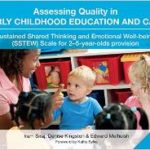Recommended Resources
The New SSTEW Scale
The new SSTEW – Sustained Shared Thinking and Emotional Well-being Scale for 2-5 year olds
by Iram Siraj, Denise Kingston & Edward Melhuish
I was very excited to see that there was to be a quality assessment tool for Sustained Shared Thinking and Emotional Well-being (SSTEW). As I’m sure you know, I’m a massive fan of Sustained Shared Thinking, and its benefits, but measuring the quality of Sustained Shared Thinking is massively difficult.
How can you really analyse the quality of interactions, which may only be a few minutes long?
The 5 scales that are used are:
- Building trust, confidence and independence
- Social and emotional well-being
- Supporting and extending language and communication
- Supporting learning and critical thinking
- Assessing learning and language
There are 7 levels from inadequate to excellent, for a total of 14 items under the 5 scales.
Anyone who has used the ECERS or ITERS will be very familiar with the format and premise for these assessments. In brief, each item is rated from 1 to 7, using 3 observations as evidence. The average scores are calculated to give you a rating and you can also calculate the mean score.
The 5 scale ratings can be entered onto a ‘scale profile’ that gives a visual representation of the 7 levels, so you can see at a glance those areas that need further work or those that are doing really well.
For example, the gradings are: Sub-scale 1 (Building trust, confidence and independence); Item 1 (self-regulation and social development) has the 7 ratings from 1, inadequate (staff do not appear to agree about the boundaries/rules/expectations or apply them consistently) to 7, excellent (Staff congratulate children when they follow the rules well – e.g. I saw you help put the tractor away).
Item 2 is: encouraging choices and independent play, from 1 (the interests of the children are not taken into account) to 7 (Staff include children in planning for the setting) and so on.
Using your professional judgement and observation skills, you would determine where on the 1 to 7 continuum the staff were operating.
Again, as with other similar quality assessment scales, there are examples and supplementary information sections for each item.
So far, so good. This all looks very familiar and similar to the ECERS and ITERS – a thorough (if time consuming) quality audit.
In my opinion, the bits that really make this publication worth the £20 are the support materials from page 48 to 60. These detail the aspects of child development that underpin the SSTEW – social development; emotional development; cognitive development and play.
The details in these sections are succinct and relevant, as well as interesting to read. The play section is particularly good, covering many different perspectives on play.
I can see these sections being particularly useful for students, who need a clear guide to these areas. But they would be equally good for anyone wanting a refresher as well. These would also be fantastic in staff meetings for practitioner’s Continued Personal and Professional Development (CPPD).
This book is an excellent combination of a quality audit and a document about child development.
And underlines the importance of Sustained Shared Thinking. What is there not to love about this book?
You can get a copy here
Kathy Brodie
https://www.kathybrodie.com/author/kathy-brodie/Kathy Brodie is an author, Early Years Professional and Trainer specialising in online training and courses. She is the founder and host of the Early Years Summit and Early Years TV, weekly Professional Development for Early Years practitioners and educators.

